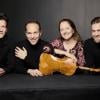
Last spring, violinist Owen Dalby and cellist Christopher Costanza were introduced to pianist Ilya Yakushev by Patricia Kristof Moy, executive director of Music at Kohl Mansion. The two string players had been looking for new performing opportunities since the disbandment of the St. Lawrence String Quartet, of which they had both been members.
After putting on a concert at Kohl last May, Dalby, Costanza, and Yakushev — now bearing the moniker of a trio with all three of their names — came together again in a similar program for the San Jose Chamber Music Society on Saturday, Feb. 22, at St. Francis Episcopal Church.
To balance out the bill, which included the 1889 revision of Brahms’s epic Trio No. 1 in B Major, Op. 8, the rest of the concert consisted of shorter works for each possible duo that the players could form, plus one solo piano piece.
Dalby and Costanza have taken on bold and declarative performing personalities. This was most obvious in their delivery of Bohuslav Martinů’s Duo No. 1 for Violin and Cello, a 1927 piece combining modernist spikiness with hints of Czech folk song. The two players tore through the traded-off phrases and complex harmonic mixing with vigor and distinct good humor. This music was lively rather than daunting.

Costanza and Yakushev took a similar approach to Nadia Boulanger’s Three Pieces for Cello and Piano. Boulanger, a renowned French musical pedagogue who taught generations of composers — including American expats from Aaron Copland to Philip Glass — also composed in her youth, producing this brief set in 1914. The first two pieces are peaceful. Yakushev softly rolled phrases, while Costanza’s cello spoke out strongly, erasing any trace of French impressionism that the piano may have given. Then came the much faster third piece, Yakushev making loud clangs on the piano and joining Costanza in a startlingly violent and joyful rendition.
The duo then played another work, Silbo (Whistle) by the contemporary Spanish cellist Andrea Casarrubios. Half spirited and half lyrical, this attractive piece creates its whistling sounds by harmonics and sliding glissandos in the cello.
Dalby got his turn with Yakushev in an arrangement of Sergei Rachmaninoff’s “Vocalise.” This was a fast-paced performance with a strong but smoothly flowing cantabile line in the violin. That no singer could achieve such continuously liquid results underscores the advantage of playing an instrument that isn’t limited by breath.

Yakushev soloed in Dmitri Shostakovich’s Prelude and Fugue No. 24 in D Minor, the final piece in the composer’s Op. 87 set in emulation of J.S. Bach’s The Well-Tempered Clavier. The pianist’s intelligent playing emphasized how the fugue subject flows directly out of the prelude. He began the fugue in a quiet, inquisitive, Bach-like manner and then built up to a fiercely dramatic and expressive conclusion. The program note’s allusion to the thundering conclusion of Shostakovich’s Fifth Symphony was not out of place.
After intermission, the entire trio embarked on Brahms’s Op. 8. This performance took a while to hit its groove. The piano sound began thick and heavy, the typical idiom for Brahms. The string playing was lighter, without enough melodic emphasis to bring out the composer’s somber and pensive themes.
The second-movement scherzo was very fast, shedding the creepiness that characterizes more measured performances. But the trio section of the movement clicked. Here the music came alive, with the melancholy theme emerging in full Brahmsian character.
The charm continued in the third-movement Adagio with an ideal balance between rocklike piano chords and sinewy strings. A headstrong and dramatic finale made a virtue out of its hurried pace. Overall, this was a fine conclusion to a varied and interesting concert dominated by robust and lively playing.




